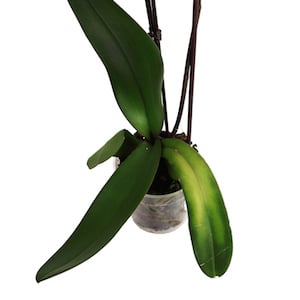
 While pleasing in their own right, orchid leaves often take a backseat to the exotic beauty of orchid blooms. But leaves can do something blooms can’t: Orchid leaves can help predict your plant’s future.
While pleasing in their own right, orchid leaves often take a backseat to the exotic beauty of orchid blooms. But leaves can do something blooms can’t: Orchid leaves can help predict your plant’s future.
How, you ask? As we explained in our last blog, the color of orchid leaves can help you recognize signs of distress. Now you know what the colors on your leaves mean, a little intervention can often return your orchid to a healthy state.
Little can be done to save an orchid after it suffers from severe sun and heat damage. As soon as you notice a yellow spot, move the orchid to an area that receives less direct sunlight and more indirect sunlight.
Next, remove the plant from its decorative vase, inspecting the orchid’s roots to determine if your orchid is dehydrated. Well-watered roots should be a healthy green color; grayish-white roots indicate more water is needed.
Rehydrate your orchid and give it a decorative look by making a humidity tray. To do this, take a shallow tray, put a layer of decorative rocks or beads in it and add a small amount of water to the tray. Set your orchid on top of the rocks.
Alternatively, you can remove the orchid from its decorative pot and run water through the grower pot for a few minutes. When the media is soaked, let the water leach out the bottom of the grower pot and return the orchid back to its decorative pot. If you notice your plant becomes dehydrated again, consider moving it to a new location that does not get as dry and hot.
Orchids flourish when they’re given generous doses of bright, indirect light, either from the sun or artificial sources, so move your orchid to a brighter room. Alternatively, you can move your orchid to a south or west-facing window, shielding it from direct sunlight with a sheer curtain.
If your orchid is suffering from prolonged exposure to cold temperatures, simply relocate the plant to a warmer part of your home. Orchids should be kept in a room with temperatures that range from 65 to 80 degrees Fahrenheit during the day and 60 to 70 degrees Fahrenheit at night. Avoid placing your orchids near heating or cooling vents or fans, as drafts also prove threatening to the health of your orchid.
Root rot often occurs when roots are overwatered or sit in water for an extended period. If you see brown or black mushy-looking roots, immediately stop watering your orchid and wait for the roots to dry. This may take up to 10 days.
If the plant does not recover, wait until all blooms fall to treat. With a sterile cutting tool, remove all rotted roots. Repot your orchid in fresh potting media. For the first week, mist the leaves in the morning to encourage new root growth. Be sure to follow the Just Add Ice® ice cube watering method after the first week.
Orchid bacterial and fungal diseases can develop quickly and spread rapidly if not promptly detected and treated. If all of your orchid’s leaves have fallen off, your plant will not recover. If the leaves are still intact, begin treating by isolating the orchid from other plants and removing infected foliage using a sterilized cutting tool.
Next, spray your orchid with a broad-spectrum, high quality fungicide, following package instructions. Do this even if you suspect a bacterial infection because your plant has a greater risk of developing a secondary infection. Move your orchid to a room with improved air circulation, lower humidity and daily temperatures between 65 and 80 degrees Fahrenheit.
Don’t let the word spider scare you; spider mites are easily controlled. First, isolate the infected plant from all others. Next, destroy any traces of web underneath orchid leaves. Then, spray or wipe horticultural oil or insecticidal soap (found at any garden center) diluted with water onto the leaves. Continue this treatment once a week for at least three weeks.
For more information on orchid leaves, download “Orchid Health: What Your Leaves are Telling You” today!

Copyright Just Add Ice® Orchids 2023